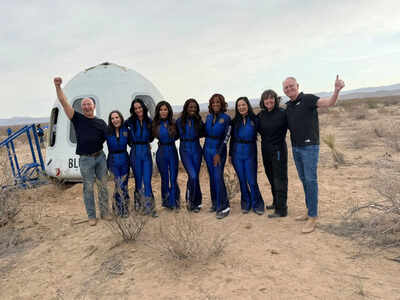
This image provided by Blue Origin shows from left: Jeff Bezos, Kerianne Flynn, Katy Perry, Lauren Sanchez, Aisha Bowe, Gayle King, Amanda Nguyen, Sarah Knights, director of Blue Origin's astronaut office, and Blue Origin CEO Dave Limp. (Blue Origin via AP)
When Katy Perry floated into microgravity aboard Blue Origin’s New Shepard rocket earlier this month—serenading fellow passengers with What a Wonderful World—it was billed as a triumphant moment for women in space. But not everyone is impressed. Critics, including space policy analyst David Pollack, argue that despite the spectacle and the star power, Perry and her fellow travellers weren’t truly astronauts. And the controversy has less to do with who was on board, and more to do with where—and how—they went.
The heart of the criticism lies in the nature of the mission. Blue Origin’s New Shepard rocket, while undeniably advanced, follows a suborbital flight path. It climbs to about 62 miles (100 kilometres) above sea level—just beyond the Kármán line, the internationally recognised boundary of space—before falling back to Earth. That short arc gives passengers about three to four minutes of weightlessness, not because they’ve escaped Earth’s gravity, but because they’re in freefall. As Pollack puts it, it’s “more roller coaster than space odyssey.”
“Crossing the Kármán line isn’t enough,” Pollack explained in his post-flight critique. “You have to stay in space—or at least orbit Earth—to be considered a true astronaut.” Achieving orbit requires a horizontal velocity of about 17,500 miles per hour—something the New Shepard doesn’t even attempt. Instead, the vehicle lobs passengers into space on a high arc, then parachutes them back down after just 11 minutes total in the air.
That’s not just a semantic difference—it’s a functional one. Pollack and other experts note that orbital missions, like those undertaken by NASA or SpaceX, involve vastly more complexity and risk. They demand life support, re-entry shielding, and sustained exposure to microgravity and space radiation. In contrast, suborbital hops are automated, short, and require minimal training.
And that’s where the term “astronaut” becomes contentious.
In the United States, the Federal Aviation Administration (FAA) distinguishes between “commercial astronauts” and “space flight participants.” Since 2021, the FAA has clarified that only crew members who “demonstrate activities essential to public safety or contribute to human space flight safety” during the flight qualify for astronaut wings. Blue Origin passengers, including Perry, don’t meet that threshold. They were not piloting the spacecraft or contributing to mission-critical operations—they were along for the ride.
Even Jeff Bezos, whose 2021 New Shepard flight helped revive the commercial space tourism race, has faced similar critiques. “It’s like calling someone who rides in an elevator a structural engineer,” one NASA veteran quipped at the time.
Of course, none of this is to say the experience isn’t extraordinary. Floating above the Earth, however briefly, is a breathtaking feat. But for critics like Pollack, calling it “space travel” is fair. Calling someone an astronaut is a stretch.
In the end, whether you’re moved by Katy Perry’s zero-gravity vocals or skeptical of the semantics, the debate underscores a broader question: As space becomes more accessible, what does it really mean to go to space?

 1 month ago
157
1 month ago
157




























 English (US)
English (US)